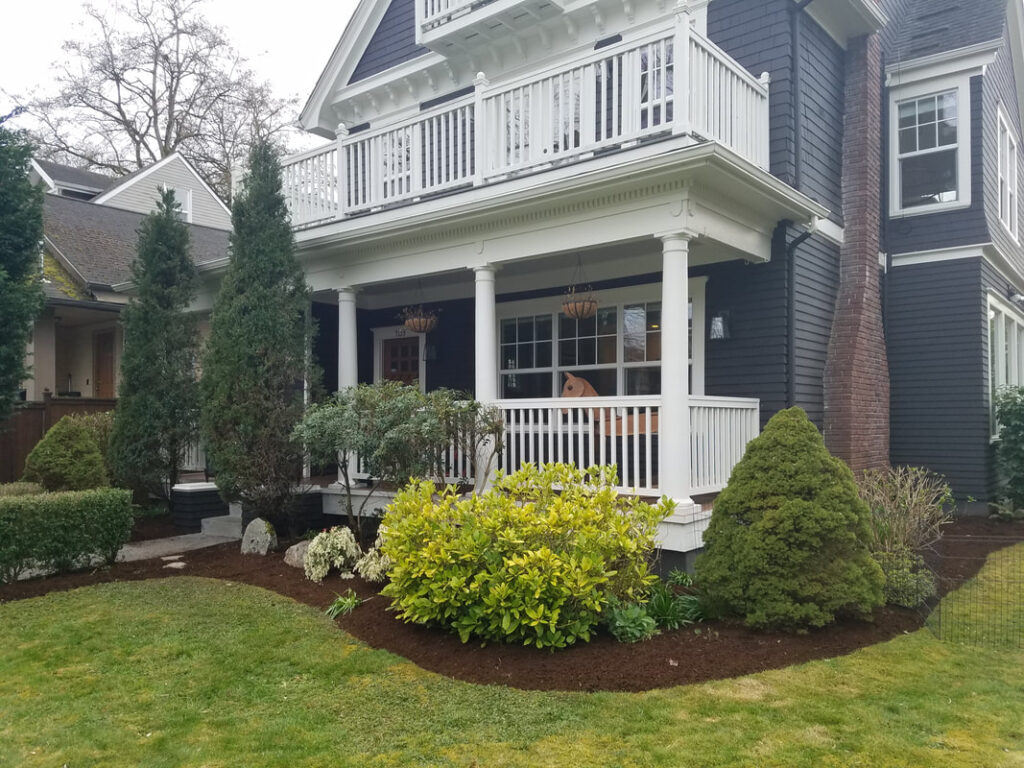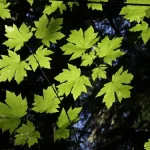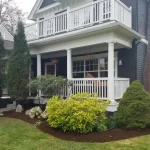Shoreline is a great place to have a plush green lawn.
It’s no surprise people take lawn care seriously in the Pacific Northwest.
Here are the best lawn care tips for the Shoreline, Washington area!
Quick Summary
- Choose the right composition of cool season grasses.
- Keep your lawn mower blades sharp.
- Mow your lawn to the right height.
- Prevent weeds with a proper fertilization schedule.
- Aerate and thatch your lawn at least once a year.

Flanked by Puget Sound and Lake Washington, the strip of land from north Seattle to Lynnwood is a natural wonder. The area has a temperate oceanic climate with mild, dry summers, and a near-constant drizzle of rain in fall and winter (and spring!).
The cloudy weather creates some challenges for lawn care. Don’t be surprised if you get moss popping up on rocks and trees, it loves water and shade.
Lawn care is about keeping everything in equilibrium. Regular mowing helps prevent invasive species, and the right soil reduces the need to aerate.
1. Know your soil
The best way to keep all the flora around your home happy is starting with the right soil composition.
Many homeowners find their lawn’s topsoil was excavated from the house’s foundation, or is exposed subsoil. You many end up with finely-textured soil, which bakes and cracks, or coarse sands and gravels, which are low in nutrients and dry out rapidly.
You’ll want soil with higher clay content with more organic matter that plants crave.
Sandy loam (60–70% sand and 30–40% combined silt and clay) is the way to go, and can be added to any soil type to amend it.
2. Use the right grass
The best way to keep your lawn plush and green is to pick the right grass to begin with. There are four main grasses that thrive in Shoreline, Washington. They are known as cool season grasses, in contrast to the warm season grasses used in the southern areas of the US. Generally, a mix of all four are used in northwest lawns:
- Kentucky Bluegrass – Lush, dark green color, low heat tolerance. It grows well in full sun to part shade areas.
- Fine Fescue – Fast-growing, soft grass that grows well in shade but doesn’t tolerate heat well. Mixes well with other grasses.
- Tall Fescue – Grows fast and looks rough/rustic. It handles dry weather the best of the cool season grasses.
- Perennial Ryegrass – Tough grass that grows quickly and grows in sun and shade.
When buying grass seed, we suggest going with a local company like JB’s or Scott’s, with seed meant for use in the northwest. For consistency, use the same product year after year, so your repairs and overseeding look best.
3. Keep your blades sharp

Just like using sharp scissors for a haircut, sharp lawnmower blades make grass look neat and well-groomed.
Dull blades will damage the plants and leave your lawn looking ragged. Make sure blade sharpening is part of your lawn care routine!
4. Height matters
There’s always the temptation to mow your grass as short as possible to save energy.
But wait! Mowing too short will stress out your lawn, especially if the grass has grown long. The rule of thumb is to not cut more than 1/3 of the grass blade’s length or you risk trouble.
Grass needs to be cut regularly to keep it healthy. Here are some rules of thumb:
- Kentucky Bluegrass – 3 to 3.5 inches in summer, 2.5 to 3 inches in spring and fall.
- Fine Fescue – 3 inches is best, but it can be cut lower.
- Tall Fescue – 3.5 inches is the minimum height to cut to avoid damage.
- Perennial Ryegrass – Can be cut at 1.5 to 2.5 inches in spring and fall, 2.5 to 3 inches in summer.
5. Set a fertilization schedule
Your lawn is like any other living organism, it needs vitamins and minerals. Proper fertilization helps keep grass thick and more resistant to drought and weeds.
Have your soil tested before adding fertilizers to it. Add lime if the pH is lower than 5.5 or if calcium content is low.
Once you have that straightened out, you’ll want to fertilize at least twice a year, in spring and fall.
In addition to N-P-K (nitrogen-phosphate-potassium), use a fertilizer with multivitamin containing sulfur, copper and iron to add important minerals like calcium and magnesium back into the soil.
6. Use good weeding practices

Prevention is the best weed removal.
Following the tips in this article will help keep weeds like crabgrass away.
Grow healthy grass that will put weeds a chokehold. Spring fertilization helps grass thicken up and prevent weeds from getting started. Mowing regularly will nip dandelions and crab grass in the bud and prevent seeds from being scattered.
Removing weeds by hand is the most environmentally-friendly way to get them out of your lawn, and there are a variety of tools that help in this effort. You can replace any divots with a bit of topsoil and some grass seed, to help fill in afterwards.
If you do need to use an herbicide, pre-emergents used before weeds show up are a way to keep them from getting established. Post-emergents are used after they’ve already broken through. “Natural” brands that derive their potency from corn gluten, salts from fatty acids, or other non-chemical sources are a good choice.
7. Break it up

Lawns get matted and soil gets compacted, creating trouble for grass to grow well. Matting prevents nutrients and light from reaching the soil, and compacted soil makes it hard for grass roots to remain vigorous.
There are a few techniques to keep lawns healthy.
First, make sure to rake your lawn out with a leaf rake a few times a year. This helps remove debris and weeds, and is a great preventative step.
If your lawn does become matted, it’s usually a buildup of dead grass, pine needles, moss, weeds, and other debris. That’s when thatch raking helps. This is a deeper raking, that pulls up more than a leaf rake will. It’s usually done in combination with aeration.
Aerating your soil means poking holes in it or pulling cores out of it. There are a number of tools you can use, both manual and powered. There are even spiked shoes you can wear and stomp around your lawn. If you have the right soil, you won’t need to aerate often, but most lawns benefit from occasional aeration.
Often, overseeding and fertilizing is done in combination with thatch raking and aerating, especially in the fall. This gives the grass seed enough time to get established before it goes dormant in winter, and continue its growth in spring.


